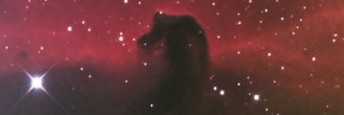Aufnahmen - Der Planet Jupiter
Er ist der größte Planet unseres Sonnensystems und kommt fast an die Leuchtkraft der Venus heran. Deshalb wird er auch manchmal mit Ihr verwechselt. Ein Blick durch ein Teleskop verrät ihn aber sofort an seinen zwei markanten Wolkenbändern und natürlich den 4 hellen Monden. Diese werden nach ihrem Entdecker auch die Galileischen Monde genannt. Sie verändern stündlich ihre Position, so dass Galileo Galilei damals lange versuchte, eine genaue Zeitmessung mit ihnen zu ermöglichen. Ein Jupitertag dauert nur knapp 10 Stunden, weshalb man bei günstigen Bedingungen in einer Nacht die komplette Oberfläche bewundern kann.
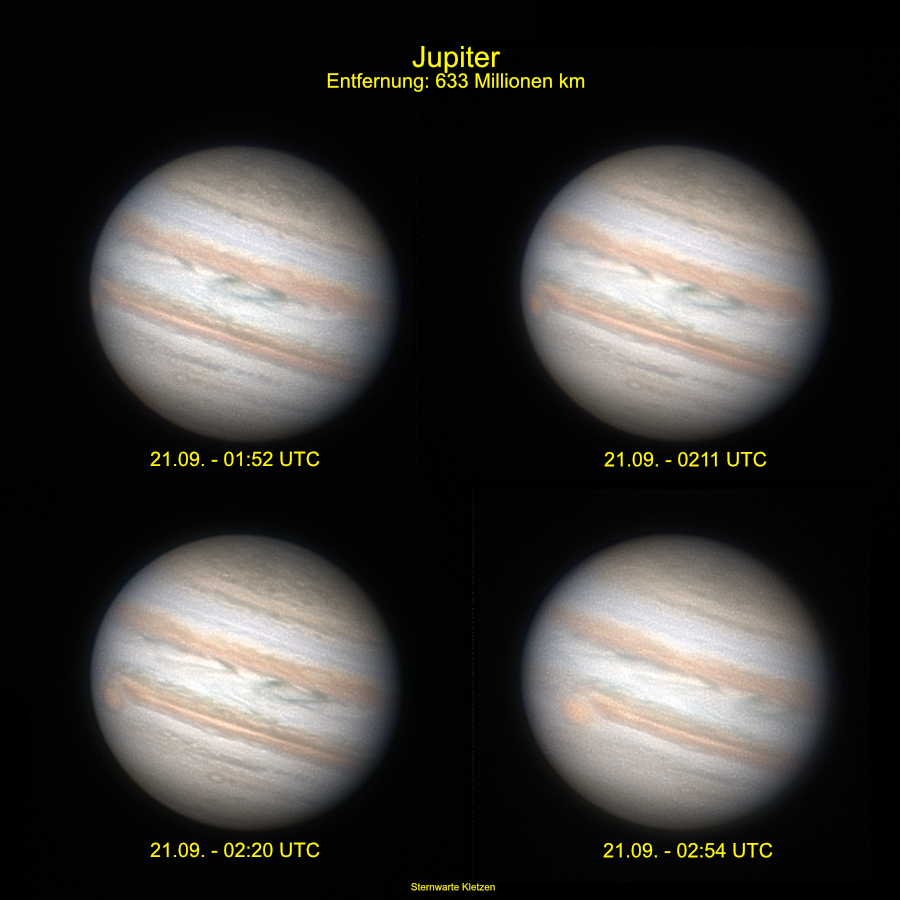 Jupiter am 21.09.2023.
Jupiter am 21.09.2023.
Höhe über dem Horizont: etwa 50°
Helligkeit: -2,9mag
Scheibarer Durchmesser: 49,5"
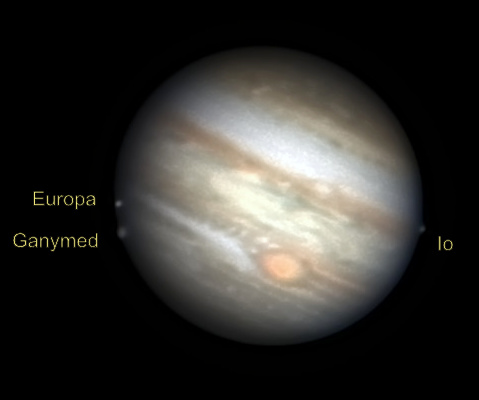 Jupiter am 02.11.2022 gegen 20:46UT.
Jupiter am 02.11.2022 gegen 20:46UT.
Höhe über dem Horizont: 37°
Helligkeit: -2,8mag
Scheibarer Durchmesser: 47,4"
Besondere Mondkonstellation: Außer Callisto befanden sich alle Galileische Monde scheinbar am Jupiterhorizont.
 Jupiter am 01.10.2022 gegen 23:39UT.
Jupiter am 01.10.2022 gegen 23:39UT.
Höhe über dem Horizont: 36°
Helligkeit: -2,93mag
Scheinbarer Durchmesser: 49,8"
Besondere Mondkonstellation: Europa mit Schatten am GRF
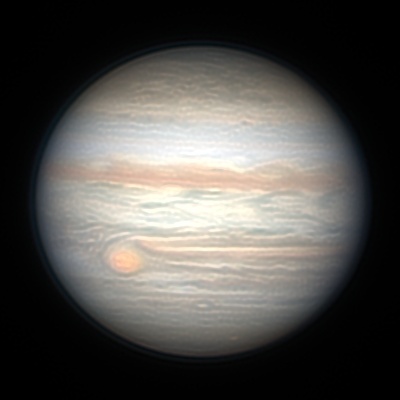
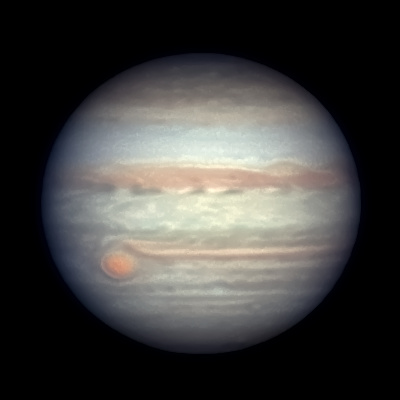 Links: 12.09.2022 gegen 22:27UT.
Links: 12.09.2022 gegen 22:27UT.
Rechts: 06.10.2022 gegen 22:04UT.
2 Bilder im Abstand von 24 Tagen.
Hier kann man etwas die Veränderungen in der Atmosphäre des Jupiter studieren.
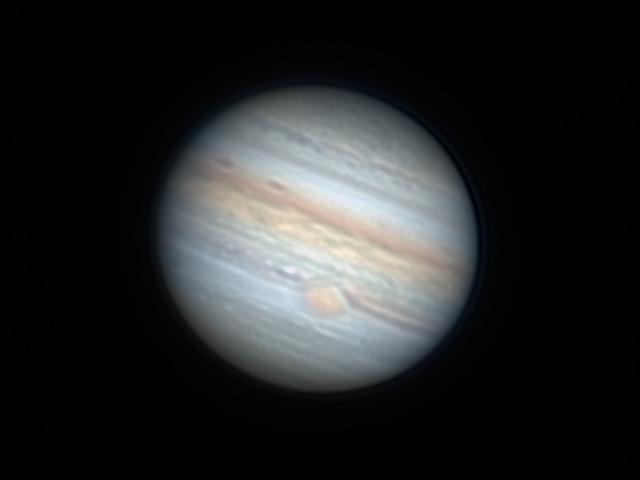
Helligkeit: -2,83mag
Scheinbarer Durchmesser: 48,4"
GIF-Animation aus 57 RGB-IR Aufnahmen (auf 256 Farben reduziert)
Pro Farb Kanal wurden 33% von jeweils 5000 Bildern gestackt.
Für den Luminanzkanal wurde ein IR-Pass Filter benutzt und 33% von 10000 Bildern gestackt.
Das Seeing änderte sich während der Aufnahmen.
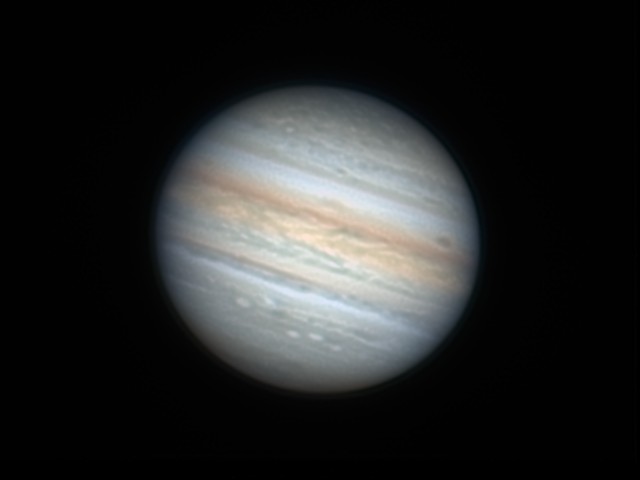
Höhe über dem Horizont: 24°
Helligkeit: -2,85mag
Scheinbarer Durchmesser: 48,7"
An diesem Abend war der Himmel besonders klar und ruhig. Die Szintillation war sehr niedrig und ermöglichten besonders detailreiche Aufnahmen.
GIF-Animation aus 12 RGB-R Aufnahmen (auf 256 Farben reduziert)
Pro Kanal wurden 33% von jeweils 5000 Bildern gestackt.
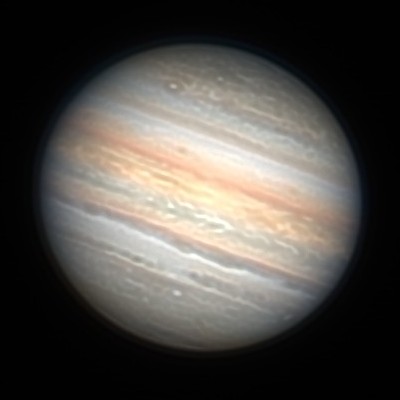 Jupiter am 02.09.2021 gegen 22:06UT.
Jupiter am 02.09.2021 gegen 22:06UT.
Höhe über dem Horizont: 22°
Helligkeit: -2,85mag
Scheinbarer Durchmesser: 48,8"
Aufnahme: RGB-IR
RGB je 33% von 5000 Frames
IR je 33% von 10000 Frames
Software: AS3!, Astra Image
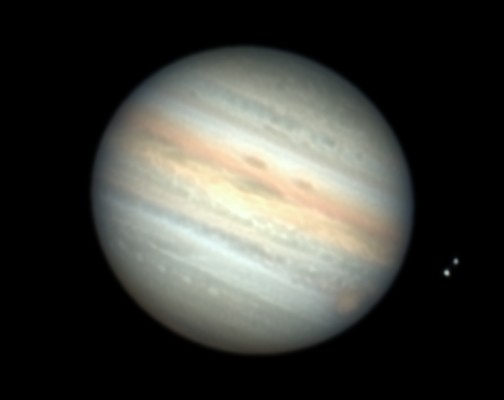
Die beiden Monde Io und Europa verstecken sich gerade hinter dem Planeten: Animation aus 5 Bildern.
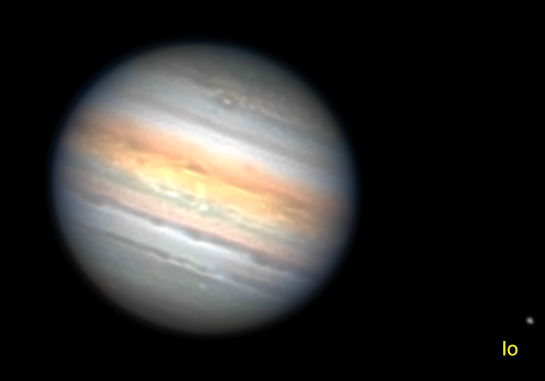 Jupiter am 14.08.2021 um 22:16 UT.
Jupiter am 14.08.2021 um 22:16 UT.
40cm Newton, ASI178MMC
Aufnahme: RGB-IR
Jupiter-Mond Io ist mit im Bild.
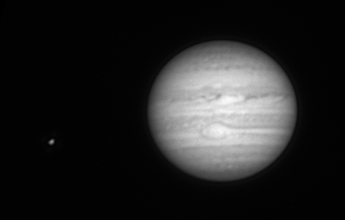
Jupiter mit Io am 26.05.2018 gegen 22:08 Uhr MESZ
16" Newton + ASI178MM + IR-Passfilter |
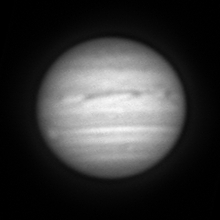
Jupiter am 28.05.2018 gegen 22:18Uhr MESZ
16" Newton + ASI178MM |
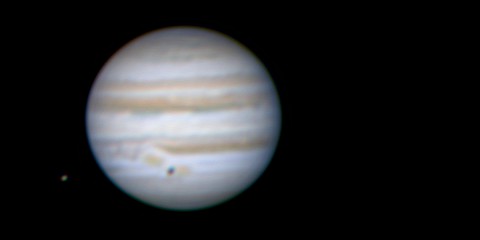
Die Animation besteht aus 50 Einzelbildern, die jeweils aus 2000 Aufnahmen gestackt wurden.
Mond Europa und sein Schatten ziehen an der Planetenscheibe vorbei.
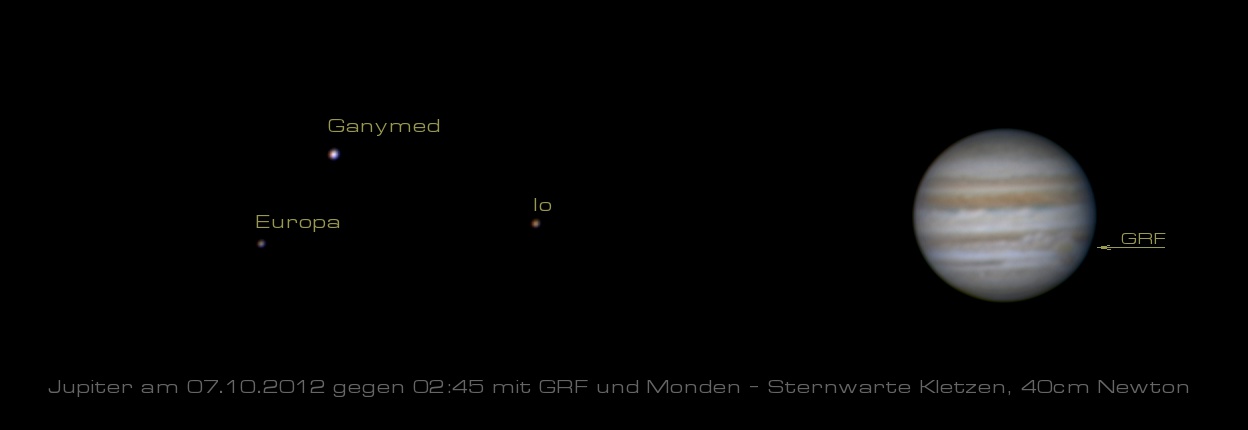 Jupiter am 07.10.2012 mit Webcam durch den 16" Newton fotografiert. Kombination aus 2 Aufnahmen in korrekter Konstellation. Bei den Jupitermonde Europa, Ganymed und Io kann man Größe und Farbe unterscheiden. Bild anklicken.
Jupiter am 07.10.2012 mit Webcam durch den 16" Newton fotografiert. Kombination aus 2 Aufnahmen in korrekter Konstellation. Bei den Jupitermonde Europa, Ganymed und Io kann man Größe und Farbe unterscheiden. Bild anklicken.
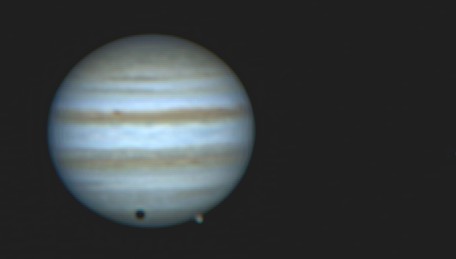
Monde: IO und Ganymed
Das Seeing verändert sich im Laufe der Nacht dramatisch.
07.11.2011, 21:00Uhr - 03:00Uhr 40cm Newton mit Webcam
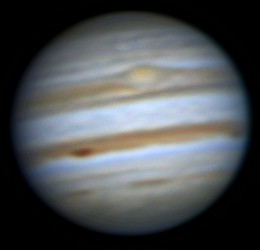 Jupiter steht im Jahr 2011 besonders hoch am Himmel. Interessant ist, dass das südliche Äquatorialband (oben im Bild) wieder zu sehen ist. Es war im Jahr 2010 von einer Schicht aus Ammoniumkristallen bedeckt und somit nicht sichtbar (siehe Bilder unten).
Jupiter steht im Jahr 2011 besonders hoch am Himmel. Interessant ist, dass das südliche Äquatorialband (oben im Bild) wieder zu sehen ist. Es war im Jahr 2010 von einer Schicht aus Ammoniumkristallen bedeckt und somit nicht sichtbar (siehe Bilder unten).
Aufnahme vom 01.10.2011 gegen 02:35Uhr mit 30,5cm Teleskop.
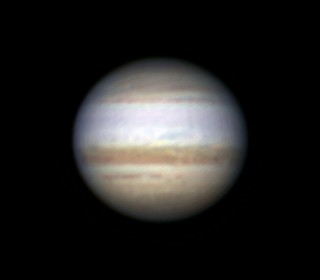
305mm Selbstbau-Newton
Okularprojektion mit 15mm Super-Plössel
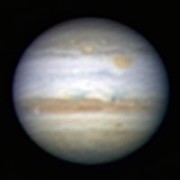
Jupiter am 14.10.2010 gegen 00:00Uhr MESZ
12"Selbstbaunewton |

Jupiter am 23.10.2010 gegen 24:00 Uhr MESZ
12"Selbstbaunewton |
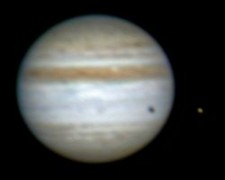
Jupiter am 10.10.2010
gegen 00:45Uhr MESZ Mond Europa und sein Schatten auf der Jupiteroberfläche |
hier klicken (ACHTUNG: Größe: 65 MB)
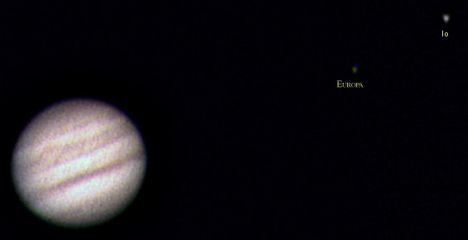 Jupiter am 26.02.2004 um 22:36Uhr MEZ mit den Monden Europa und Io.
Jupiter am 26.02.2004 um 22:36Uhr MEZ mit den Monden Europa und Io.
| Am 31.03.2004 flog der Jupitermond Io zwischen 22:00Uhr und 23:50Uhr MEZ vor seinem Planeten vorbei und warf dabei einen Schatten auf die Oberfläche des Jupiter. So kann man indirekt den Vorbeiflug sehen, denn Io leuchtet zu schwach, um ihn direkt vor der grellen Jupiterscheibe sehen zu können. | |||||






|
|||||



